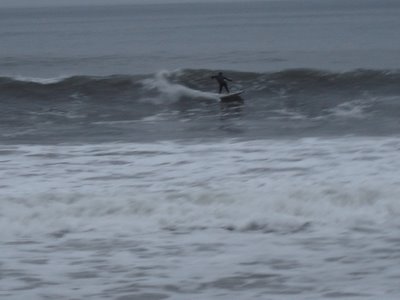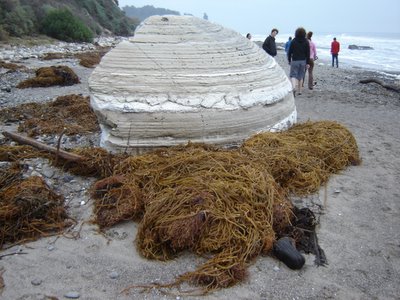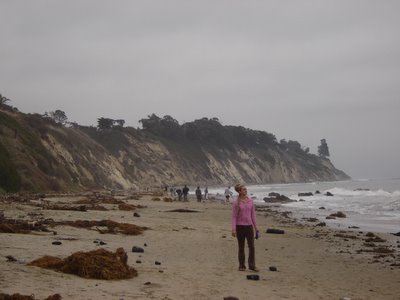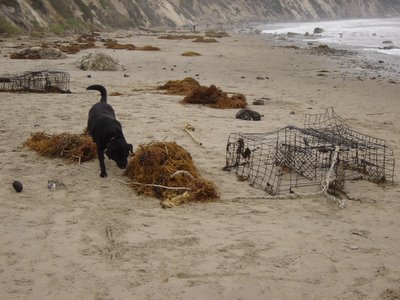 My daughter was upset with herself for not bringing her board when she came up from Long Beach for Christmas.
My daughter was upset with herself for not bringing her board when she came up from Long Beach for Christmas.
Here in the Santa Barbara Channel there are extensive forests of giant kelp (Macrocystis pyrifera) offshore. All this wave action has uprooted kelp and piled it up on the beach.
 Kelp has always looked very strange to me, so rubbery and full of those knobby gas bladders that keep it suspended in the water. It seems otherworldly and looks hardly like a plant at all. It is an essential part of the near shore ecosystem providing food and shelter to a wide variety of fish and other sea critters.
Kelp has always looked very strange to me, so rubbery and full of those knobby gas bladders that keep it suspended in the water. It seems otherworldly and looks hardly like a plant at all. It is an essential part of the near shore ecosystem providing food and shelter to a wide variety of fish and other sea critters.
 In this view you can see wads of it strewn all along the beach. This is Hendry's Beach looking east toward Arroyo Burro.
In this view you can see wads of it strewn all along the beach. This is Hendry's Beach looking east toward Arroyo Burro.
 It is still lobster season here, and many unfortunate fishermen have had their traps yanked up and thrown on the beach as well. Here's our lab Maggie checking out a couple of them. You can see the mooring line attached to the one on the right. We saw probably a dozen or so in a quarter-mile stretch and the floats of many more just off the beach where they had been pushed into shallow water. I'm told these traps cost about $75 apiece.
It is still lobster season here, and many unfortunate fishermen have had their traps yanked up and thrown on the beach as well. Here's our lab Maggie checking out a couple of them. You can see the mooring line attached to the one on the right. We saw probably a dozen or so in a quarter-mile stretch and the floats of many more just off the beach where they had been pushed into shallow water. I'm told these traps cost about $75 apiece.
The kelp forests here are commerically harvested. Large boats clip the top few feet off the plants and pull them on board. This harvest is heavily regulated and the total annual take in California is about 50,000 tons (wet weight). Some is processed and sold as dietary supplements but the majority is used by chemical companies to make compounds used as thickening agents in the commerical food industry. So think about that the next time you have Jell-o or ice cream.
2 comments:
Raised in Portland OR, I spent much time on the Oregon coast and can just smell the oily iodine of that kelp! You're right -- it has a sort of science fiction "feel" and look to it and the kind of entanglement that makes one expects something -- A scuba diver? A mermaid? An octopus? -- to be dragged ashore in it. Agar Agar, made from seaweed, is very useful stuff. Nicely spread in the bottom of a sterile Petri dish, it can raise a crop of surprising entities!
I recall movies of people who live on the rocky islands of the Atlantic off the coast of Britain and how they haul all that seaweed up to their potato beds, hoping it will convert to fertile soil -- and it does.
Prairie Mary
In the Jan 8 NYTimes Book Review is a piece on a book called "The Whale Caller" By Zakes Mdo. It appears to be a cross between "The Whale Rider" and a reverse "Moby Dick," since the whale caller is very much in love with his whale.
What's relevant here is that the whale is called with an instrument created from a kelp -- the bulb for the flare at the end -- this is coiled like an English horn while it is new and wet, then dried to keep the form. Kind of on the principle of the digeridoo, I guess.
Post a Comment